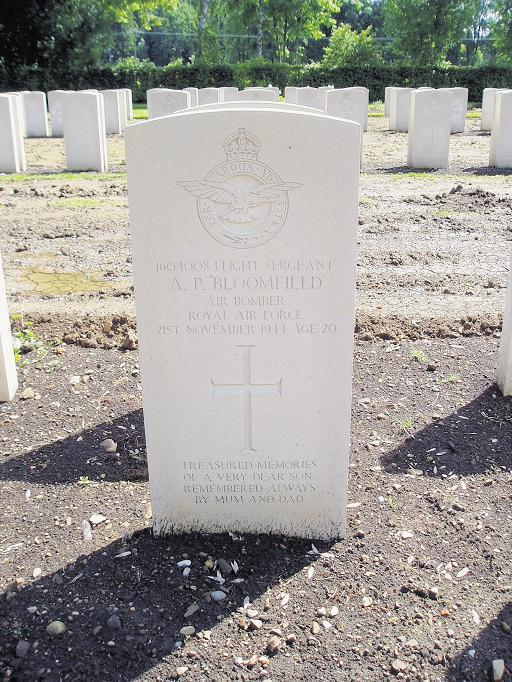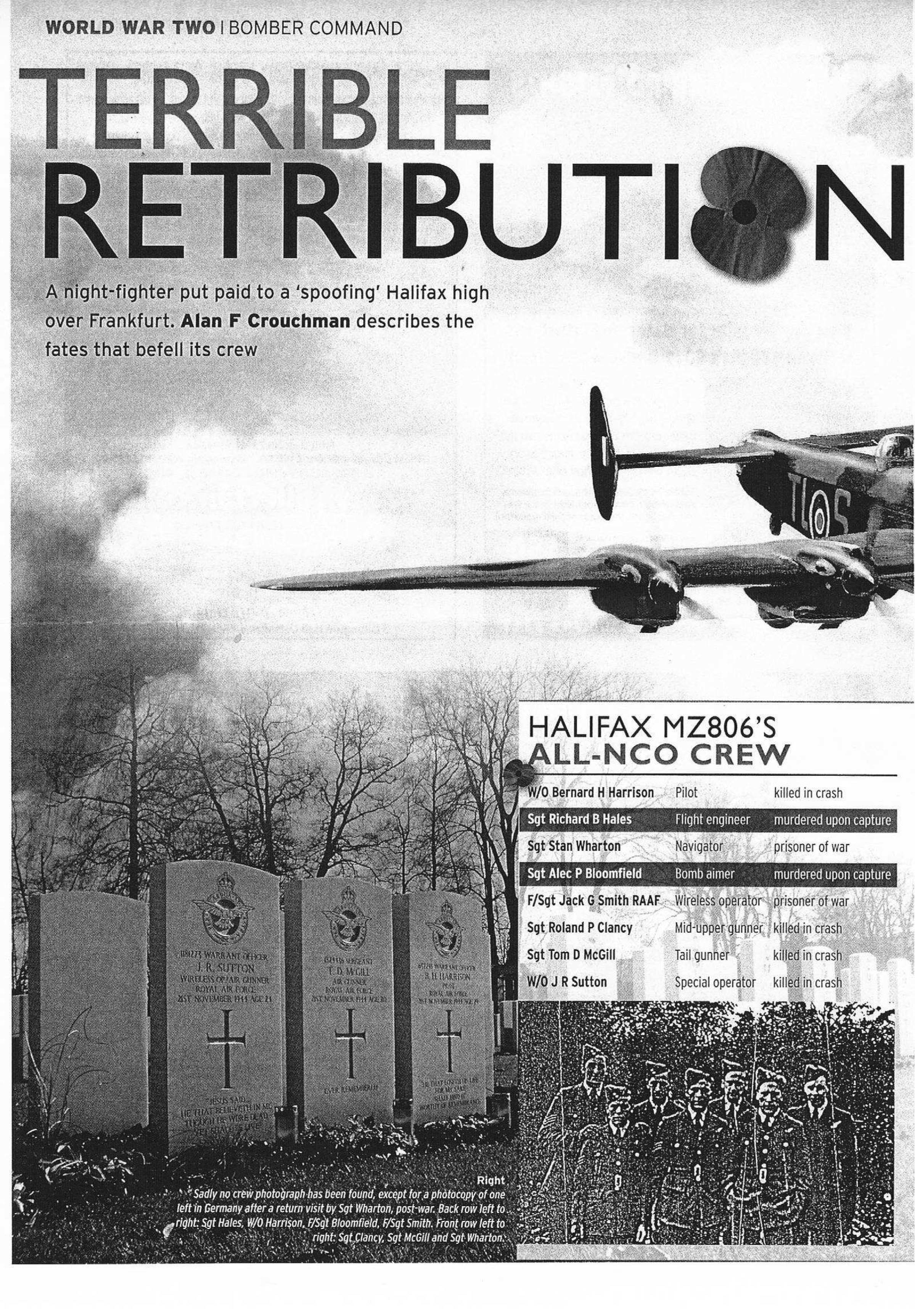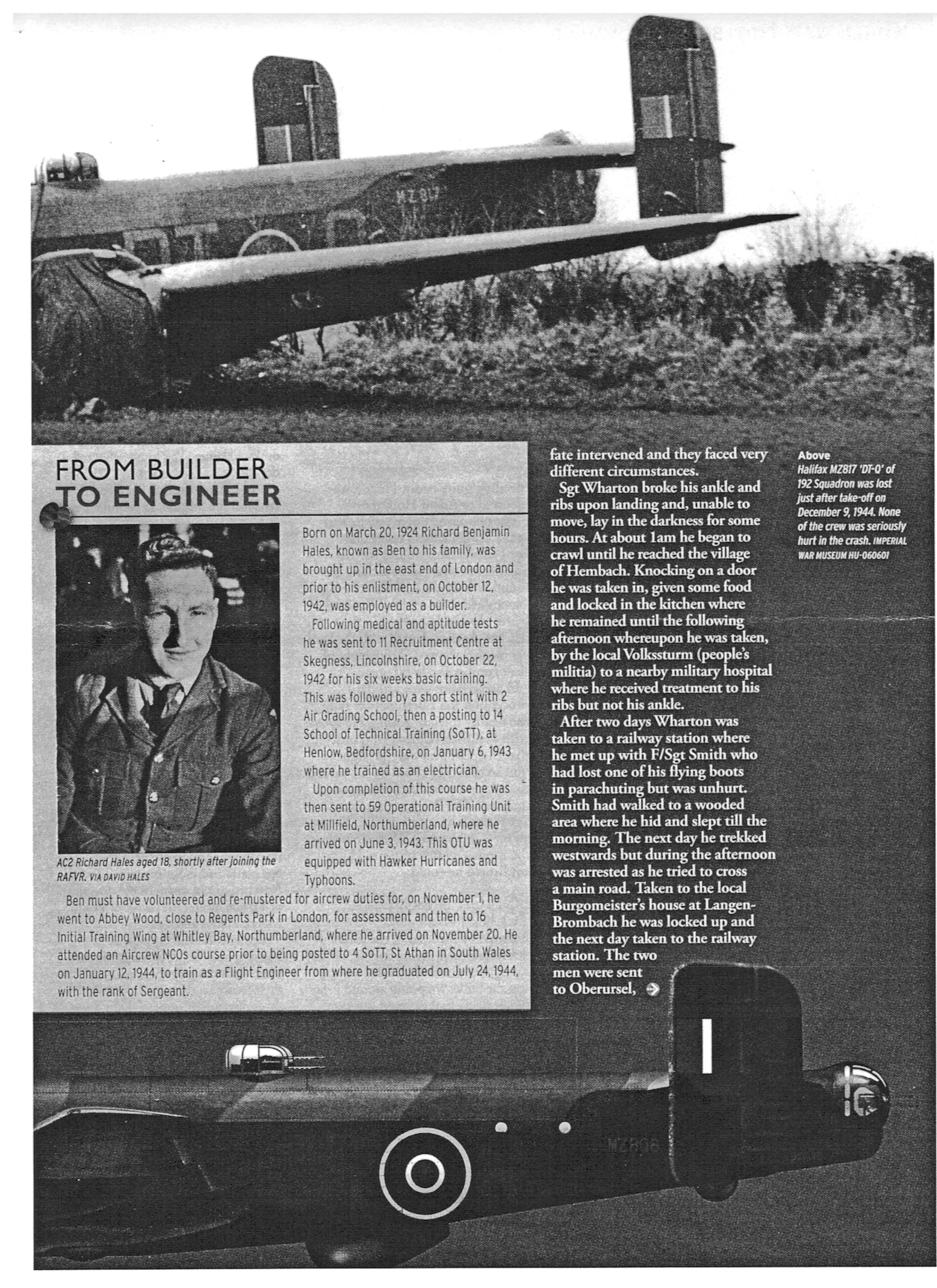History 1944- Nieder-Kinzig/König in the earlier District Erbach/Odenwald/Germany: Terrible Retribution- Halifax MZ 806`S
The title-photo (Copyright: David J. Hales) shows a part of the Durnbach War Cemetry 1939-1945 in Bavaria/Germany
Literature/Report in English:
„World War II TERRIBLE RETRIBUTION – A night- fighter put paid to a spootingHalifax high over Frankfurt. Alan F. Crouchman describes the fates that befell its crew, pages 22 ff. (Quelle: „FlyPast“ – Issue October 2011, ISSN 0262-6950 (Distributed By: Seymour Distribution Limited, 2 Poultry Avenue, London, EC1A 9PP, Tel: 020 7429 4000 Fax: 020 7429 4001 PRINTED BY: Warners (Midland) plc, Bourne, Lincs) – Printed in England
Literature in German:
Thomas Seifert: Recht in Trümmern- Die Zerstörung des Rechtsstaates in der Zeit des Nationalsozialismus, dargestellt an zwei Beispielen aus dem Odenwald. S.9-38 (Quelle: „gelurt“ Odenwälder Jahrbuch für Kultur und Geschichte 2020 – Herausgegeben vom Kreisarchiv des Odenwaldkreises, ISBN: 978-3-9815625-9-0/ ISSN: 0947-4870 – Verkaufspreis 18,00 Euro- Druck: M&K Satz-, Druck- und Verlags-GmbH Michelstadt, Erbach im Odenwaldkreis- First issue 27. November 2019- Printed in Germany )
Original-Text/Quelle: The Reading Chronicle
The day the world stopped for a fearless airman and his comrades

THE men who flew in Bomber Command were a breed apart. They knew they were unlikely to complete their tour of 30 missions. Only history would show that half of all those brave men would perish in their efforts to prosecute the war in the skies over Germany. But they knew the risks from the empty bunks the morning after a mission. JEREMY BLOOMFIELD has researched the brief Royal Air Force career and shocking death of one such man, a member of his own family, 20-year-old Alec Peter Bloomfield, who was born and grew up at 30 Surrey Road in Whitley, with his parents Ben and Eleanor (Nell) and younger sister Kathleen.
ALEC volunteered for aircrew, yet must have known the risks. Perhaps the invincibility of youth insulated him against concerns that must have been felt by his parents who had already lost their daughter to diptheria.
He became a bomb aimer, training initially in South Africa then joining an Operational Training Unit where he formed part of a crew, all non-commissioned officers. Trained on Halifax heavy bombers they were posted to 192 (Bomber Support) Squadron at RAF Foulsham, Norfolk. to take on a role not as bombers but in countermeasure operations, including dropping strips of foil known as ‚window‘ to block enemy radar, listening for new enemy radio frequencies and undertaking decoy raids.
Their first mission on November 11, 1944 over Koblenz passed without incident. Bad weather curtailed the next day’s mission while equipment failure forced them to abort mission number three on November 15.
When Alec climbed aboard Halifax MZ 806 DT-R for what would be his final flight on November 21, little could have prepared him for the horror to come.
Their route would take them with the main bomber force – 238 Lancasters from 1 Group and 38 Lancasters and eight Mosquitos from the Pathfinder Force – to attack the marshalling yards at Aschaffenburg near Frankfurt. MZ806 was the lone Halifax.
They took off at 3.58pm and joined the main bomber force over Beachy Head en route for Germany where just two of the Lancasters would be lost while inflicting Aschaffenburg’s worse night of the war – with 300 killed and more than 500 homes destroyed.
For Alec and his crew the flight was uneventful and, because they were not actually bombing, they were able to skirt the target.
But while making some turns and dives they were attacked from behind by a German night fighter, the starboard engines caught fire and when navigator Sgt Stan Wharton, unable to contact the pilot, gave the order to bale out, Alec dived through the hatch.
The doomed plane crashed near the village of Kirch-Brombach with the pilot and three crew still aboard. But four crew made it to the ground alive, Sgt Wharton and wireless operator Flight Sgt Jack Smith, an Australian, who were both sent to a POW camp.
Alec and Sgt ‚Ben‘ Hales got down close to the hamlet of Nieder-Kinzig. Alec explained to startled local man Adam Wilhelm that he was English and, making no attempt at resistance, went with him to the Burgermeister Adam Hofferberth*, followed by curious villagers, one of whom then found Sgt Hales with a nasty thigh wound.
* The house of Adam Hofferberth/Nieder-Kinzig in this time (little picture) of this post-card (Copyright: Heimat- und Geschichtsverein Bad König e.V.)

Both were well treated and Alec was given sacking to tie around his foot, because he’d lost a boot, to make the walk to the nearby town of Konig to be processed as POWs. Quite how Sgt Hales managed it I don’t know but, escorted by three policeman they were in Konig by 10pm bound for the local jail.
However fate was about to play its hand. In October 1944 Hitler had ordered the creation of a national people’s militia known as the Volkssturm and in nearby Erbach some new recruits were holding a farewell party for their instructors. Nazi party member Georg Jaeger told the officer in charge, Lt Otto Maurer, about the fliers and local Nazi Party leader Wilhelm Schwinn ordered them to be rounded up, telling his men ‚you know what to do‘!
They ordered the police sergeant to hand Alec and Sgt Hales over and began marching them to Erbach. Lt Maurer and Jaeger drove ahead, stopping their car in the road and as the prisoners approached ordered them onto a path.
As they obeyed, a machine gun opened up and Alec died instantly, shot in the back. Sgt Hales vanished into the darkness but both bodies were found next morning.
The retribution meted out to Alec and Ben doubtless happened to other downed airman who simply reported ‚missing‘, despite the fact that summary execution contravened the Geneva Convention.
The police sergeant was over-ruled by his superiors when he tried to bring charges, even though Jaeger openly admitting the killings, albeit claiming they were attempting to escape.
You might think that in the Germany of 1944, with the invasion well under way, no-one would have cared about two Allied airman. But when the area was liberated by the Americans, a Russian POW reported what villagers had told him about the murders. An American Investigation Unit, coincidentally the same one that first entered Dachau concentration camp, took statements and the truth emerged.
The bodies of Alec and Ben were exhumed from their unmarked grave in the Bad Konig cemetery and autopsies, carried out by Lt Col Jesse E. Edwards who later became a prominent US heart surgeon, showed Alec was hit four times at very close range.
Schwinn, Maurer and two others were brought to justice. One other committed suicide before his war crimes trial and two more died in a car crash. The accused blamed each other but were all convicted and received sentences ranging from five to 15 years.
On the first anniversary of Alec’s death his mother Nell wrote to Sgt Hales’s mother; the pain and grief palpable in her words, recalling how in his letters Alec would say ‚we flew over your chimney pots again last night‘ and how she wished she could hear him say it again.
Those who perished alongside him Reading’s Sergeant Alec Bloomfield were Warrant Office Bernard Harrison – Pilot, Sergeant Richard ‚Ben‘ Hales – Flight Engineer, Sergeant Roland P Clancy – Mid Upper Gunner, Sergeant Tom D McGill – Tail Gunner, Warrant Office J R Sutton – Special Operator.
They flew, and now lie, together for eternity in the Commonwealth War Graves Cemetery at Durnbach, Munich. May they Rest In Peace.
I am indebted to David John Hales (Sergeant Hales‘ nephew) from Leavenheath, Suffolk, for generously sharing the huge amount of research he has undertaken. Without him this story could not be told.
Alec had numerous aunts, uncles and cousins in the Reading area, descendants of his great grandfather, Benjamin Bloomfield, a miller at the St Giles Mill in Mill Lane.
As a keen family historian, if any relatives would like to get in touch with me I would be delighted to hear from you.
Alec was a keen photographer – maybe one of you has his snaps?
email pic 3212bloom of Alec Bloomfield’s headstone in Munich credit David Hales
Nach mehr als einem Dreivierteljahrhundert- eine Kuchenform kommt im Juni 2020 ans Tageslicht, hergestellt aus Propellerteilen der Halifax MZ 806`S
„Für Frieden in Form gebracht- Das Ergebnis einer Umwidmung kriegerischer in friedliche Zwecke hat sich in Bad König erhalten: Ein Bäcker hatte Metall eines Weltkriegs-Fliegers als Kuchenform verwendet“ (Titelseite 1)/Kriegsflieger zu Kuchenformen- Bei Hascherts in Nieder-Kinzig ist ein Blech aus Metall einer abgeschossenen Halifax erhalten geblieben“ (S. 9) Von Gerhard Grünewald (mit zwei Fotos von Dirk Zengel/ ein Foto Halifax-Militärmaschine v. Stadtarchiv Worms/VRM-Repro) Quelle: Odenwälder Echo vom Mittwoch, 9. 6. 2020












